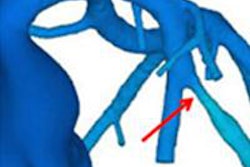Tuesday, December 3 | 3:10 p.m.-3:20 p.m. | SSJ02-02 | Room E450A
Is contrast-enhanced dedicated breast CT (CEBCT) better than tomosynthesis and digital mammography for visualizing suspicious lesions? Researchers from the University of California, Davis Medical Center will address this question during this Tuesday scientific session.John Boone, PhD, and colleagues included 105 patients with 103 BI-RADS category 4 and 5 lesions. Fourteen patients had digital mammography plus tomosynthesis, 45 had digital mammography and CEBCT, and 44 received all three. All the lesions were biopsied. Two radiologists read the exams and assigned a visibility score between 0 and 10, with 0 equal to "not seen" and 10 equal to "excellent visualization."
Of the 103 breast lesions, 58 were malignant and 45 were benign. Malignant masses were more visible on contrast-enhanced breast CT than on tomosynthesis or digital mammography, with a score of 9.7, compared with 7 and 6.9, respectively. Malignant calcifications were equally visible on all three modalities; benign masses were equally evident on CEBCT and tomosynthesis, and both were better than digital mammography (8.2, 8.5, and 7.3, respectively). The visibility of benign calcifications was equal on tomosynthesis and digital mammography, but it was much less on contrast-enhanced breast CT (8.4, 8.7, and 4.2, respectively).
Although the study results suggest that CEBCT is better than the other two modalities for visualizing malignant masses, the fact that it does not visualize benign calcifications well could lead to false positives, the group concluded.





















